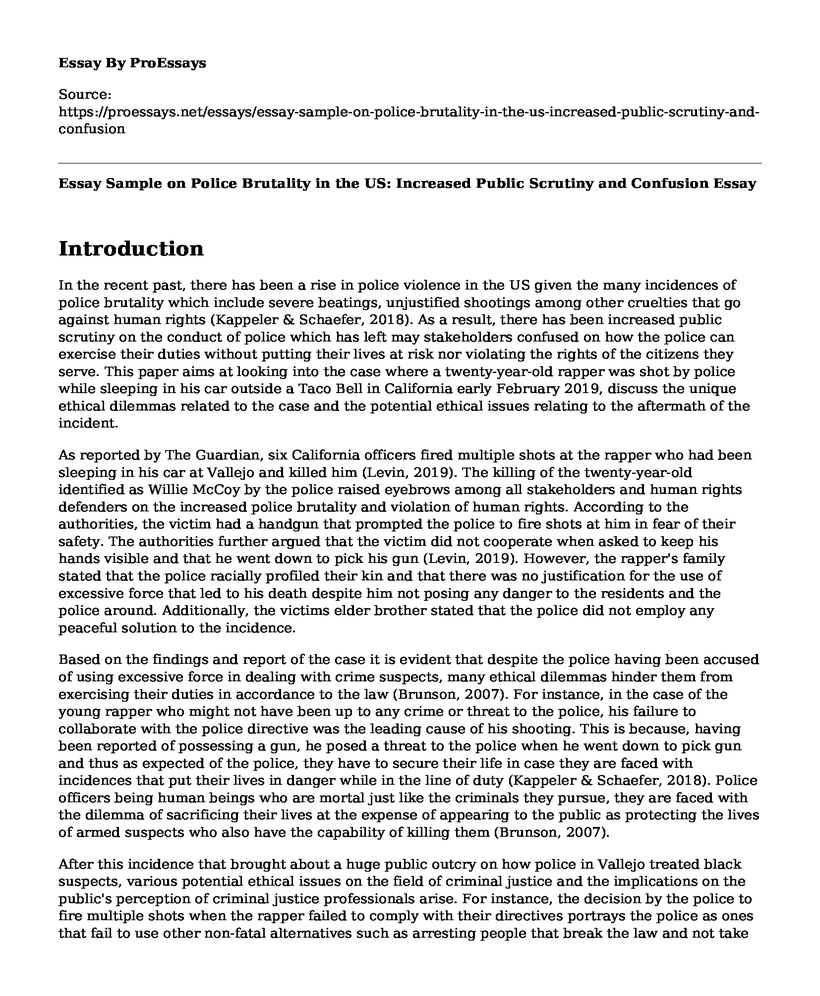Introduction
In the recent past, there has been a rise in police violence in the US given the many incidences of police brutality which include severe beatings, unjustified shootings among other cruelties that go against human rights (Kappeler & Schaefer, 2018). As a result, there has been increased public scrutiny on the conduct of police which has left may stakeholders confused on how the police can exercise their duties without putting their lives at risk nor violating the rights of the citizens they serve. This paper aims at looking into the case where a twenty-year-old rapper was shot by police while sleeping in his car outside a Taco Bell in California early February 2019, discuss the unique ethical dilemmas related to the case and the potential ethical issues relating to the aftermath of the incident.
As reported by The Guardian, six California officers fired multiple shots at the rapper who had been sleeping in his car at Vallejo and killed him (Levin, 2019). The killing of the twenty-year-old identified as Willie McCoy by the police raised eyebrows among all stakeholders and human rights defenders on the increased police brutality and violation of human rights. According to the authorities, the victim had a handgun that prompted the police to fire shots at him in fear of their safety. The authorities further argued that the victim did not cooperate when asked to keep his hands visible and that he went down to pick his gun (Levin, 2019). However, the rapper's family stated that the police racially profiled their kin and that there was no justification for the use of excessive force that led to his death despite him not posing any danger to the residents and the police around. Additionally, the victims elder brother stated that the police did not employ any peaceful solution to the incidence.
Based on the findings and report of the case it is evident that despite the police having been accused of using excessive force in dealing with crime suspects, many ethical dilemmas hinder them from exercising their duties in accordance to the law (Brunson, 2007). For instance, in the case of the young rapper who might not have been up to any crime or threat to the police, his failure to collaborate with the police directive was the leading cause of his shooting. This is because, having been reported of possessing a gun, he posed a threat to the police when he went down to pick gun and thus as expected of the police, they have to secure their life in case they are faced with incidences that put their lives in danger while in the line of duty (Kappeler & Schaefer, 2018). Police officers being human beings who are mortal just like the criminals they pursue, they are faced with the dilemma of sacrificing their lives at the expense of appearing to the public as protecting the lives of armed suspects who also have the capability of killing them (Brunson, 2007).
After this incidence that brought about a huge public outcry on how police in Vallejo treated black suspects, various potential ethical issues on the field of criminal justice and the implications on the public's perception of criminal justice professionals arise. For instance, the decision by the police to fire multiple shots when the rapper failed to comply with their directives portrays the police as ones that fail to use other non-fatal alternatives such as arresting people that break the law and not take the law by their hands through killings (Brunson, 2007). Also, on the public perception of the criminal justice professionals like the police, there are potential ethical issues that arise from the case such as the continued disrespect of the blacks and the perception that blacks are naturally criminals despite the existence of many law-abiding black Americans. Through these acts by the police, their credibility and professionalism as criminal justice professionals are jeopardized as they appear to be biased towards some race that has innocent individuals (Brunson, 2007).
Conclusion
In conclusion, it is evident that despite some criminals posing a danger to the lives of law enforcers, the killing of Willie McCoy portrays the rot within the American criminal justice system where professionals take the law in their hands instead of following the laid down procedures of dealing with crime. Additionally, the case shows how criminal justice professionals are biased towards blacks, which further complicates the efforts of bringing justice to victims.
References
Brunson, R. K., (2007). "Police don't like black people": African- American young men's accumulated Police experiences*. Criminology & Public Policy, 6(1), 71-101. doi:10.1111/j.1745-9133.2007.00423.x
Kappeler, V. E., & Schaefer, B. P., (2018). The Police and Society: Touchstone Readings, Fourth Edition. Long Grove, IL: Waveland Press.
Levin, S. (2019, February 13). Six California officers fire shots at rapper who had been asleep in the car, killing him. Retrieved from https://www.theguardian.com/us-news/2019/feb/12/california-police-shooting-willie-mccoy
Cite this page
Essay Sample on Police Brutality in the US: Increased Public Scrutiny and Confusion. (2023, Jan 14). Retrieved from https://proessays.net/essays/essay-sample-on-police-brutality-in-the-us-increased-public-scrutiny-and-confusion
If you are the original author of this essay and no longer wish to have it published on the ProEssays website, please click below to request its removal:
- Trauma Among Victims of Terrorism: Psychological Paper Example
- Essay Sample on Crime and Violence Trends
- Essay Sample on Los Angeles Homeless Crisis
- Essay on Savannah's Struggles: A Tale of Chronic Disease, Poverty & Alienation
- Essay Sample on Transforming Life Through Family Violence Intervention Program
- Women Empowerment: Achieving Gender Equality in the Publishing Industry - Essay Sample
- 9/11: How US Policy Changed After Terror Attacks - Essay Sample







